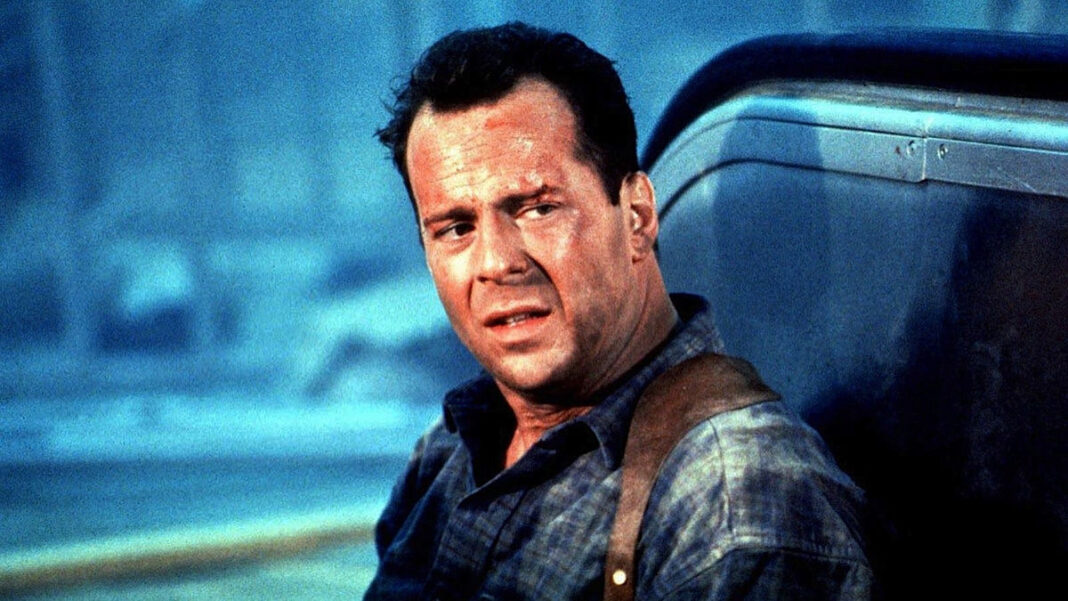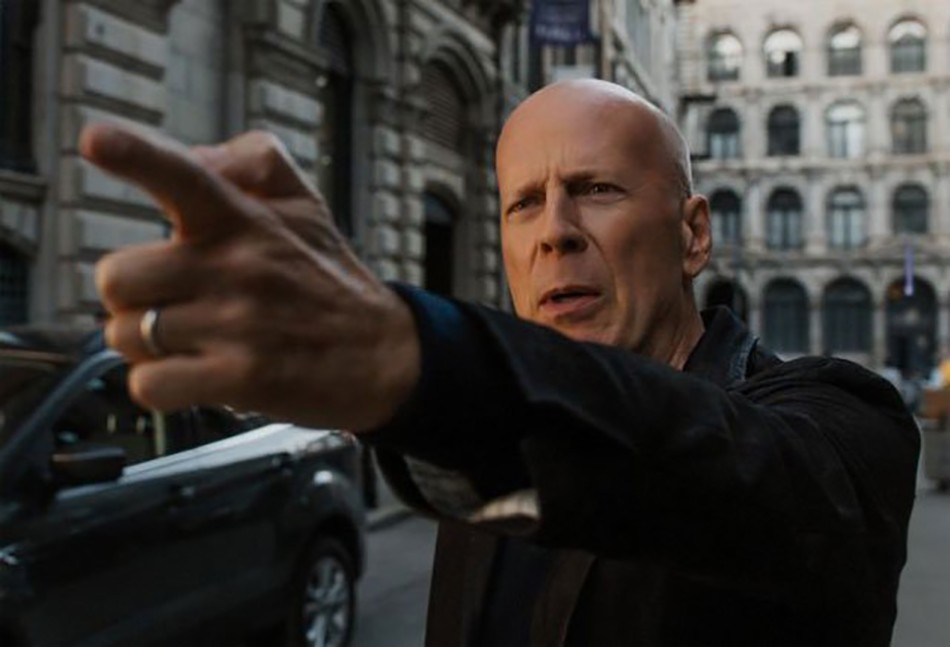So much for the element of chance. In frank defense of Die Hard 2: Die Harder.
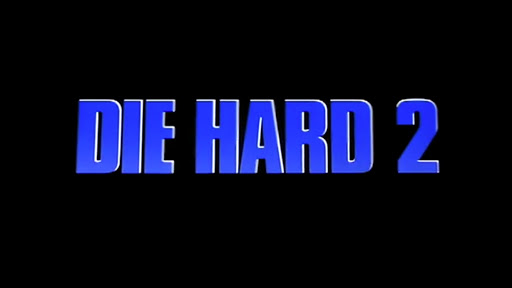
Let’s get one thing abundantly clear: Die Hard 2 was a humongous deal for moviegoers back in the summer of 1990. If you lived around that time in your teenage or adult years chances are you saw the previews, the billboards, interviews on late-night shows, the full-page adds in the newspapers with glowing reviews. “It’s the best of the blockbusters!”, announced Joel Siegel on Good Morning America. 20th Century Fox was confident to open it on the Fourth of July weekend and you can bet theaters were jam-packed with moviegoers all across the board.
It amazes me in this era of fast-paced media interaction and screen accessibility that the majority of commentators dismiss this action-packed sequel like none of the build-up, expectations, and first reactions from the multitude as they walked out of the theater never meant a thing. Nowadays many go the usual route, hailing the first one as the best ever (which it surely is!) or cramming all the entries -five so far- to see which ones are disposable or not. Even its lead Bruce Willis has been on record saying it’s one of his least favorite.
Bruce Willis Returns for ‘Die Hard 2’
Well, excuse me. Die Hard 2: Die Harder was not only one hell of a good time at the movies, it is to this date the closest to a Die Hard sequel out there. It was released two years shy after the original, so the John McClane character and his way of facing adversity was still very fresh on people’s minds. Producer Joel Silver, alongside Charles and Lawrence Gordon (they conformed Silver Screen Partners IV) were still in command and brought back screenwriter Steven E. De Souza, now sharing credits with Doug Richardson instead of Jeb Stuart, and music composer Michael Kamen. Not only did Willis reprise his moviestar-making role, audiences were pleased to see Bonnie Bedelia again as Holly “McClane”, William Atherton as the unscrupulous reporter Richard Thornberg and, although briefly, Reginald VelJohnson as Sargeant Al Powell.
Two key players behind the camera that didn’t come back due to commitments on The Hunt for Red October were director John McTiernan and cinematographer Jan De Bont. And it shows. One could only wonder what the results would have been with their involvement. The former eventually returned to the series with Die Hard with a Vengeance (1995) and the latter was already calling his own shots in Speed (1994).
Enter an Eager Renny Harlin
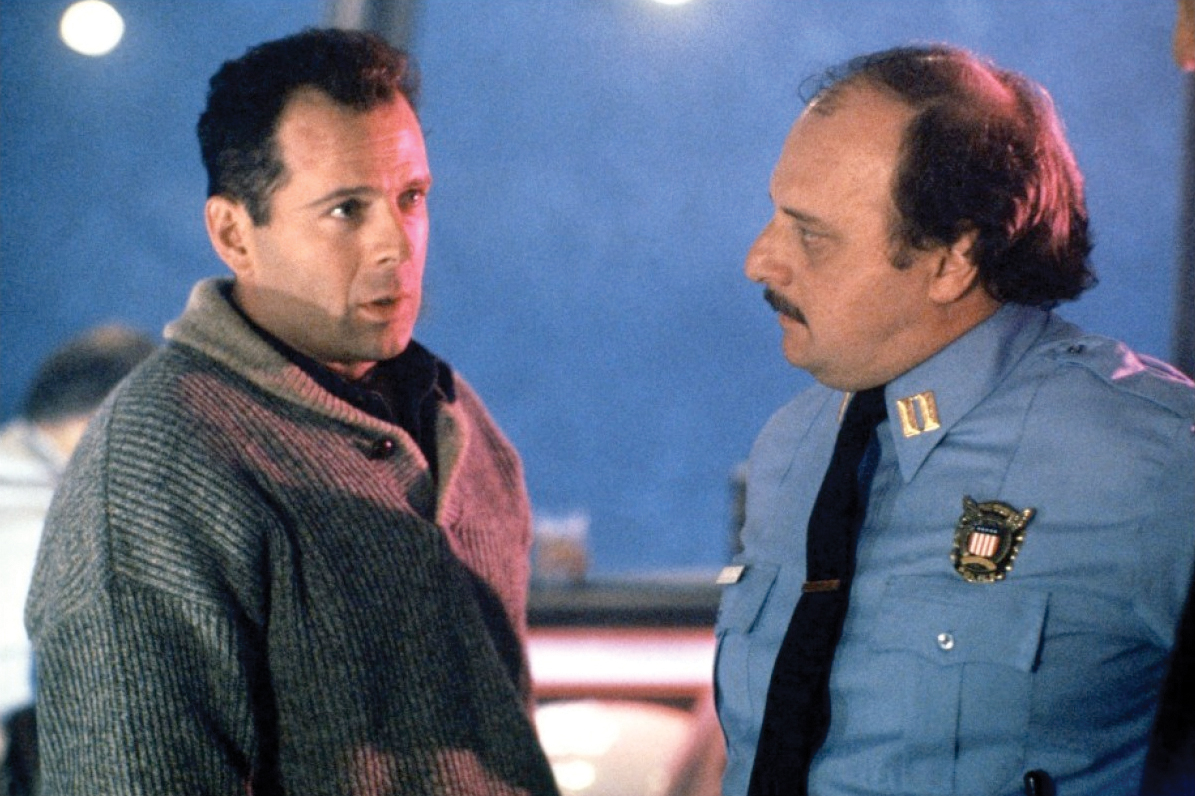
Hiring a young Finnish and yet-to-be-proven Renny Harlin, alongside DP Oliver Wood, was a big gamble. That year the same studio gave Stephen Hopkins (also an up-and-comer) the reigns of the another McTiernan-less sequel: Predator 2. And both turned out highly competent if you ask me. You could sense that the foundations of the formula and structure were intact, but the energy in the way they were told was somewhat different. Die Harder delivered true to its words. It was bigger, faster, bloodier, heavier on the one-liners, and ultimately colder. It was set yet again around Christmas, only this time on a busy and very snowy Dulles International Airport in Washington, D.C.
“Oh, man, I can’t fucking believe it. Another basement, another elevator. How can the same shit happen to the same guy twice?”, complains McClane inside the furnace of the new setting, always thinking out loud like he were sitting next to some other member of the audience.
Long gone are Hans Gruber and his band of fully armed thieves. For this occasion the antagonists are a group of ex-military men lead by Colonel Stuart, played with stone cold intensity by William Sadler. He has one of the best villainous introductions in movie history: practicing Tai Chi, naked, in his hotel room while the expository newscast covers the extradition of General Ramon Esperanza (Django himself Franco Nero). You can see the inprint from screenwriter De Souza as the fictitious Republic of Val Verde is borrowed directly from Commando (1985), which he also wrote, only this time it’s subbing for Panama and its overthrown dictator Manuel Noriega, although in the movie the character looks more like Fidel Castro.
This is the first indication that Die Hard series has now entered the movie-movie world and guys like McClane and John Matrix existed in the same universe. Remember subtleties like the rumor that Arafat bought his John Phillips suits in London? That doesn’t apply here.
7 Examples That Prove Stallone’s ‘Cliffhanger’ is Just ‘Die Hard’ on a Mountain
How Do You Make a Sequel of a Perfect Action Movie?
Honestly, Die Hard didn’t require a sequel. It is perfect as it is. I happened to find out there was a one the moment I caught the trailer on a Saturday afternoon while visiting some relatives who owned one of those huge satellite dishes. I remember some scenes from the airport, a military squad coming in response to a threat and the alert inside the control tower. In-between sequences the title was spliced by a letter. D… I… E… H… Like Wheel of Fortune, I was figuring out the name Die Hard (?) when… number 2 appeared, now cutting to John McClane, who comes rolling out over the floor to dodge some bullets, aiming his gun back and shooting at the viewer. I literally jumped out of the couch. Unbelievable! My instant second reaction was: What would his purpose be this time? He killed all the bad guys in the first one. Or did he?
One possible scenario came to mind. Straight from Argyle’s mouth, the limo driver outside of what was left of Nakatomi: “If this is their idea for Christmas, I gotta be here for New Year’s”. Perhaps on his way back to New York to settle pending commitments, McClane is intercepted at LAX not by poser thieves but by the real terrorists, ex-comrades of Gruber from the earlier days, in retaliation to his actions.
I happened to watch Die Harder twice in theaters some months later with my parents and siblings (yep, Die Hard is kinda a family thing). It was my first weekend off military boarding school (I was there by choice, although grades from my previous school would say otherwise). It was like a gift from heaven. My first reaction was a glimpse of nostalgia over the first one, but what a great ride this new one was.
A true sequel would have started with McClane at the hospital recovering from his flesh wounds, specially his cut foot. Then you’d have authorities coming in and out of his room to question him, like it happens to Bradley Cooper in The Place Beyond the Pines (2012). Holly would be by his side, at some point bringing Lucy and Jack to reunite them with their father. The media outside trying to get a scoop on the heroic cop. Later own, an investigation would force the New York policeman to go back into Nakatomi and explain West Coast officials where he hid originally, how he confronted the perpetrators one by one. This would make him face the aftermath of his actions while contemplating the wreckage and the victims that were left behind. McClane is emotionally broken at this point. He has trauma. Some detractors, like Dwayne T. Robinson, keep coming at him to falsely accuse him of being part of the heist. Will the newfound romance with his wife last? Together, he and his buddy Al Powell cope with everything while the kids are playing Jungle Jim in the backyard and eating ice cream.
But nobody goes to Die Hard to watch a drama. As a moneymaking rule in Hollywood every sequel stays true the bloodline of its genre. And then some. Fittingly so, a prerequisite to helm an entry of this caliber seems to call for a director who has made his bones through some elements of gore. McTiernan as we know tackled Predator, while Harlin dreamed of A Nightmare on Elm Street 4: The Dream Master (1988).
Every death must be larger-than-life. One bad guy gets shot in the knees while running immediately jumps head-on to a thick office window. That’s a “die hard” moment. What Harlin brought to the sequel was truer to a horror catalogue: head gets smashed by a luggage compressor, construction ladder breaks a guy’s spine in half, sticking an icycle into someone’s eye, getting sucked by a 747 turbine…
This Bruce Willis Look-a-Like Aims to Play Young John McClane
“So much for the element of chance”
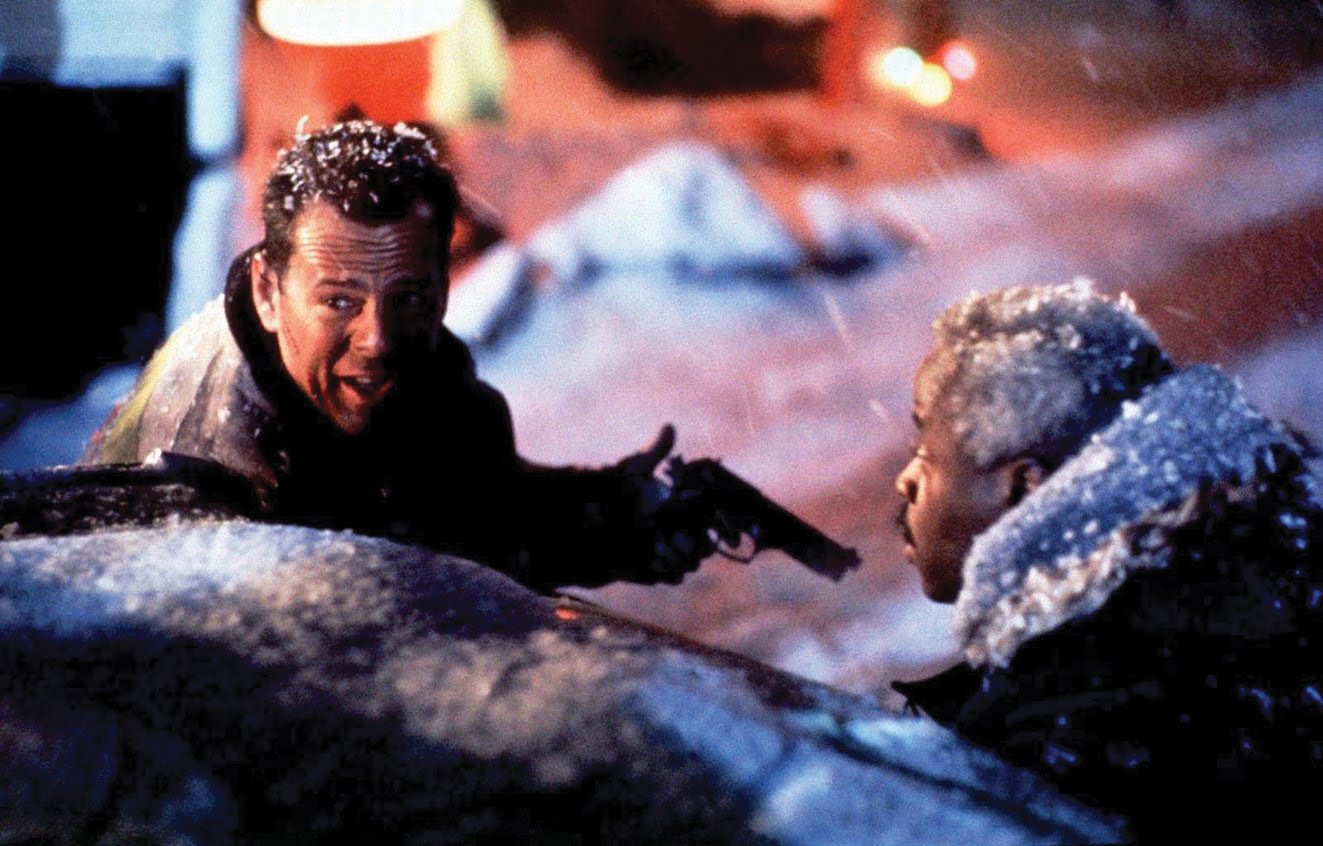
Then you have McClane against the odds. “So much for the element of chance”, as Stuart would say believing that the man has died. No other sequel justified his return like the scene he ejects his seat out of the exploding military plane. That money shot of Willis flipping out in the air is all entertainment. “You lucky fuck”, says the voice of Don Harvey, playing one of the mercenaries. Nobody at my screening was not laughing right then and there. Kudos to Industrial Light & Magic, the company responsible for the visual effects.
Besides those super delayed hand-grenades or falling from the wing of the plane without a broken bone, the character was kept mostly grounded. There was still a human side to him. He bled, sweated, and even cried. Notice how he walks in the airport at the beginning when he comes to pick up his wife. He’s not a celebrity, just another individual walking among the crowd. He still smokes. When he randomly bumps into the villain, both men seem familiar to one another. “I get that a lot. I’ve been on TV”, says Stuart, to which McClane replies: “Yeah, me too” (Moonlighting, anyone?).
Nosy female reporter Samantha Coleman (Sheila McCarthy is likable in the role) does recognize him on the spot while awaiting for the deposed military man to arrive in Washington. “The ghost of Christmas past!”, she greets him in one of the terminals, as does the stubborn airport police chief Carmine Lorenzo (Dennis Franz at his ranting best) in his office. And one crisis one platoon leader Major Grant (John Amos, another great supporting player) angrily admits: “You’re the wrong guy in the wrong place at the wrong time”. McClane’s reply? “Story of my life”. Classic!
Later on in the game it only takes to mention the hero’s last name through walkie-talkies for Stuart to finally remember and sum him up: “Oh, McClane. John McClane. The policeman hero who saved the Nakatomi hostages. I read about you in People magazine. You seemed a bit out of your league on Nightline, I thought”. Funny to compare that Hans Gruber was the type of man who read his articles in Forbes and Time… and somehow must have missed 60 Minutes.
That McClane is now a L.A. officer to live with his wife and kids and that Thornberg got two of his teeth knocked out by Holly (and now have to face her and interact without a truce on the same commercial flight to Dulles) are the minor aftermaths that have evolved from the prior events. Is kinda brilliant that every tidbit here and there blends into the story accordingly, considering that it is the adaptation of the Walter Wager book 58 Minutes. Add to the fact that it’s totally unrelated to the Roderick Thorpe novel Nothing Lasts Forever, the source material to the events in… oh, you know that already.
Working off of ’58 Minutes’
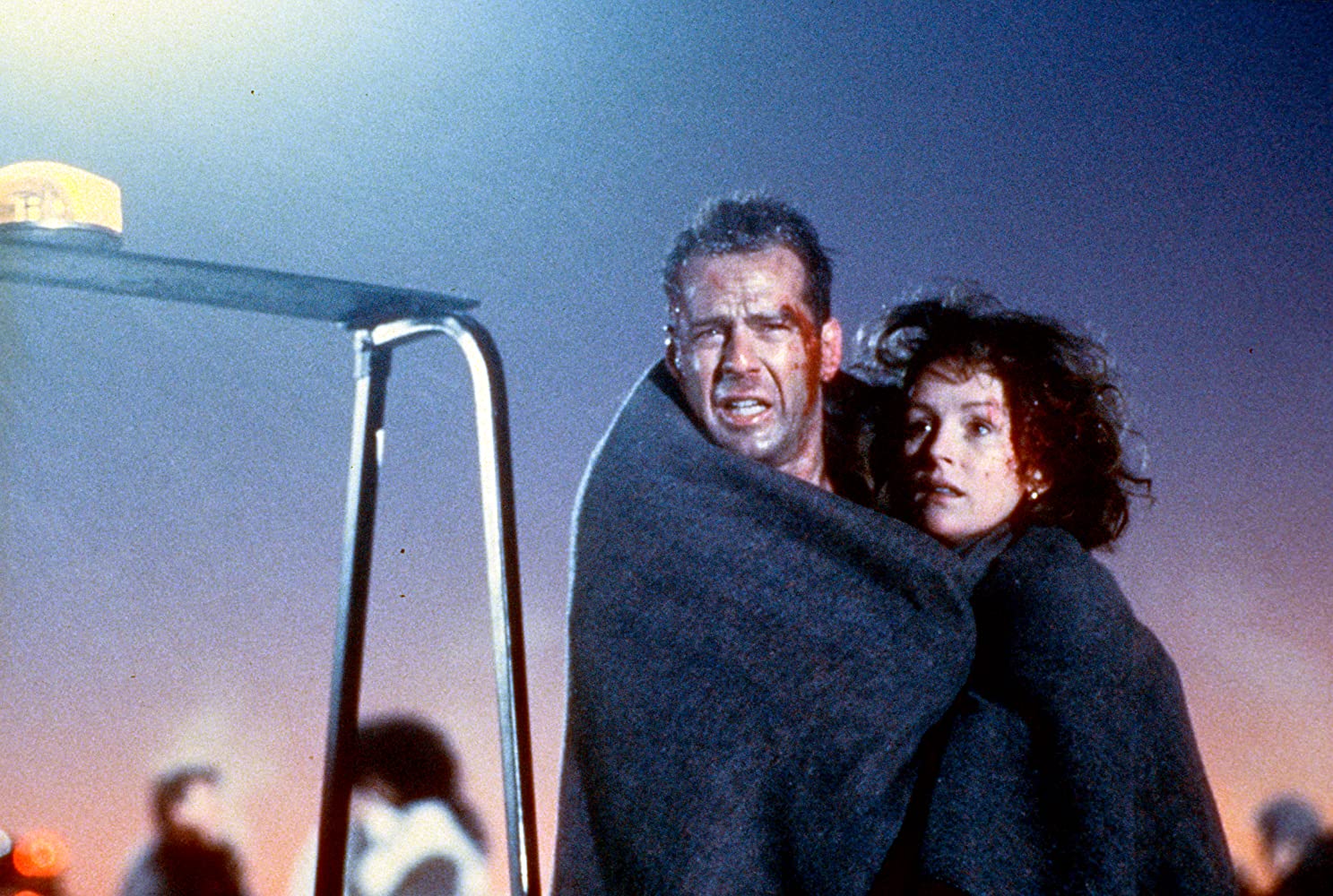
The second Die Hard benefits from being the adaptation of an established property, too. It’s not just that the setting has changed to an airport or the one-liners have gotten broader: “Hey, Carmine, let me ask you something. What sets off that metal detector first? The lead in your ass or the shit in your brains?”. It’s also about how the character fits into the new plot: mercenaries take over airport to retrieve dictator to his freedom while keeping dozens of planes hostages in the air.
That’s one hell of a premise, sure, but there must be some sacrifices to keep the bigger picture going. There are more places for McClane to run around, he’s not as isolated anymore and is fully clothed this time around. One minute he can argue with those in charge of the air traffic control tower (Fred Dalton Thompson and Art Evans… man, does this cast get any better?), the other he finds a sidekick in an underground janitor named Marvin (Tom Bower), who listens to Patty Page’s Old Cape Cod on a record player, makes references to past US wars and knows every corner of the airport. The media is even painted on a brighter side, although pricks like Thornberg like the blow the whistle and spread panic (the chaos at the airport was very well staged). Even authority figures like Lorenzo might turn in McClane’s favor this time with the right amount of blanks fired. But John always ends up walking the walk alone, with his shoes on this time.
Die Harder doesn’t waste any time. It starts with the sounds of the words -and number- colliding together on the big screen. It opens and closes with McClane’s in-law’s car getting towed only to have the fine pardoned by the end of the incredible ordeal. The first action set piece clocks in at the fifteen minute mark and it involves emergency lights, steam and steel structures. There’s an icy blue feel in Wood’s camera that contrasts the brown and grey edges of De Bont’s in the first one. The pacing is fast and efficient, thanks to maverick editor Stuart Baird. It’s broad. Characters abound on the ground as they do up in the sky. The march of Colonel Stewart and his men getting out in a hallway and into the elevators in cover formation with the doors closing with them inside is pretty cool. Kamen’s score is more playful in looser segments while attuned to the fundamental key notes of the character’s dilemma.
With McTiernan we had a slower build-up abrogated with Beethoven’s Ode to Joy (Ninth Symphony, Fourth Movement) while Harlin goes for extreme gamesmanship like the snowmobile chase and technological achievements of the era that included air phones and faxes to identify a dead man’s fingerprints (McClane thinks progress peaked with frozen pizza). By the time we have reached the spectacular annex skywalk shoot-out the viewer is sucked in. “Damn it, I hate it when I’m right”. We’re back in Die Hard territory, baby, no questions about it. You barely know there’s a thing called reality outside the walls of the theater.
One glaring plot hole involves the Justice Department representatives that had no comments when their presence at the airport was first reported. They’re nowhere to be seen for the rest of the movie. Was it really just routine? Then there’s a worn-out twist by now that caught many off-guard back in the day, hinted minutes before during a firefight that involved red tape and blue tape mags. However, once you’re caught in the middle of the spectacle you don’t rush to such hints or jump to quick conclusions. The rollercoaster is still going.
I’m drawing these impressions from a 70 MM screening I happened to catch at the Alamo Drafthouse in downtown Austin a couple of Christmases ago. It was a grandeur. Movies like these belong up there, never on TV. Such edge, vibrant colors and rousing noises at play… it’s criminal to just own it in a cramped box set movie collection. (Mr. Harlin, if you are reading this, a new 4K transfer, special edition and/or director’s cut would be much appreciated).
The Legacy of Bruce Willis’ John McClane
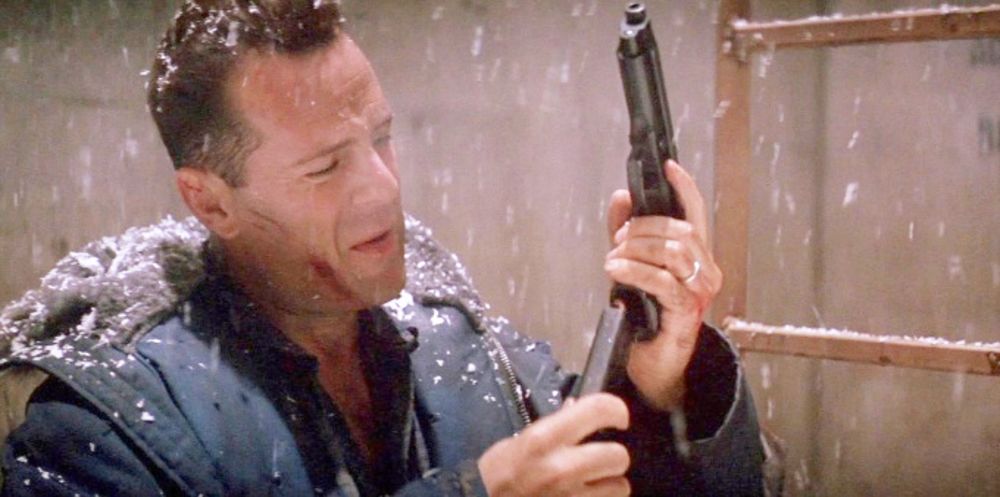
Now, Bruce Willis. The man was at his peak at this point. Die Hard was a runaway hit in ’88 and this project was to be his first tentpole as an established star. McClane’s everyman was a welcomed return by action fans. Turns out his wit and determination, mixed with a little bit of sarcasm and street-smartness, was still pretty much needed. In our eyes he is the hero. Flawed, foul-mouthed but good-hearted. To other characters in his surroundings he is very much a pain in the ass.
He asks an airport staffer if he has the key to the door after witnessing some early suspicious activity and flashes his badge with arrogance. “Because I want you to open it up. That’s why”. He can also be gentle. When the car dealership lady flirts with him, he in return shows his wedding ring. “Just the fax, ma’am. Just the fax”. Then you have the defeated and humane moments after the shocking crash of a British airliner. “I wanted to help those people tonight. I was pretty goddamn useless”, he laments.
Other delightful character treats abound when he talks to himself, ranging from “Oh, we are just up to our ass in terrorists again, John?” to “Just once, I’d like a regular, normal Christmas. Eggnog, a fuckin’ Christmas tree, a little turkey. But, no. I gotta crawl around in this mutherfuckin’ tin can”. All leading up to his signature “Yippee-ki-yay, motherfucker!”, where he finally acknowledges to the audience the genesis of his own heroics last time around, right before he is about to blow the enemy’s getaway plane up in flames, thus creating the much needed landing lights for the other “stranded” aircrafts.
Yes, it seems repetitive that he’s out saving his wife again and ride off to the sunset to the tune of Let it Snow! Let it Snow! Let it Snow! by Vaughn Monroe one more time (… for old times sake?). When John finally reunites with Holly, she says she was told there were terrorists in the airport. “Yeah, I heard that too”, replies the husband, all banged-up and a bloody mess. Another rousing laughter from the audience.
Nevertheless, much more was at stake this time. Earlier when it was suggested that the planes flying around might run out of fuel and land on the White House lawn, there’s a quick cut of McClane not liking the sound of that. The character became the unwarranted patriotic banner the summer of 1990 needed (a month later after its release the Gulf War started). He’s not only out there risking his neck for someone he loves and save thousands of innocent people along the way, he is also up to defend the United States and its Presidency, namely George Bush, Sr. “I don’t like to fly”, reminds us McClane when he hops in a TV news helicopter. “So, what are you doing here?”, asks reporter Coleman. His reply is true national sentiment: “I don’t like to lose, either”.
It was unfortunate Willis didn’t embrace that Great American Action Hero title for long as he expressed he was done with the series and wanted to return to his comedic origins with Hudson Hawk (1991). And we know how “that” turned out (note: I really like Hudson Hawk). He and producer Silver would bounce back a fourth time with The Last Boy Scout before the partnership split for good. Because in this world of action and mayhem nobody wants to go on a whimper, everybody wants to die hard. Or die harder. Accept no substitutes.

